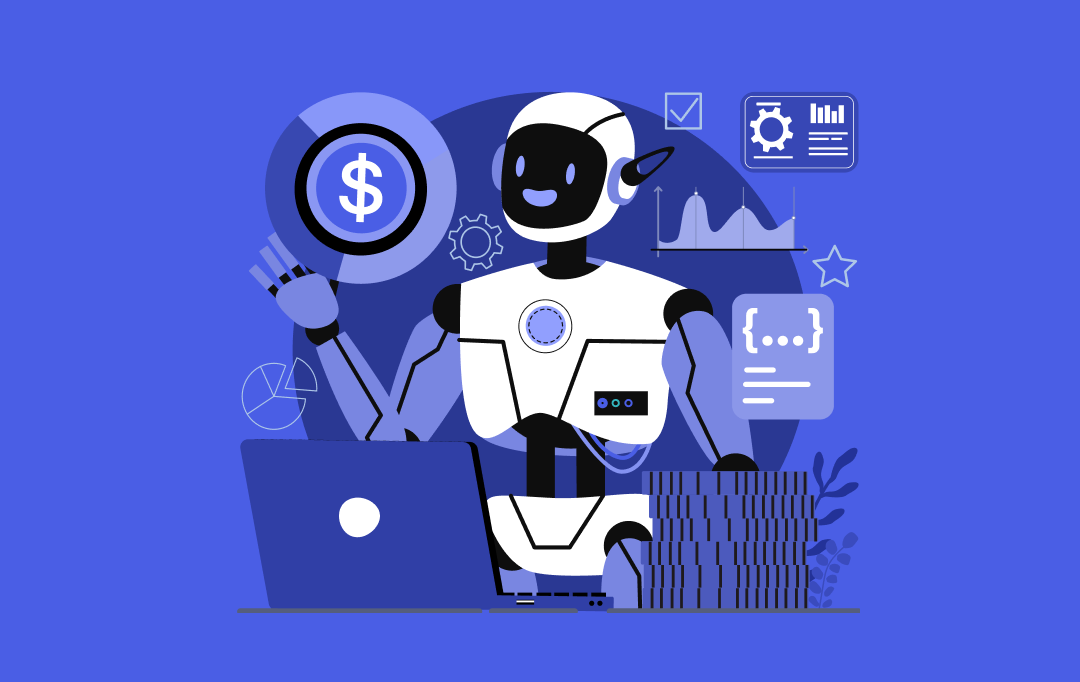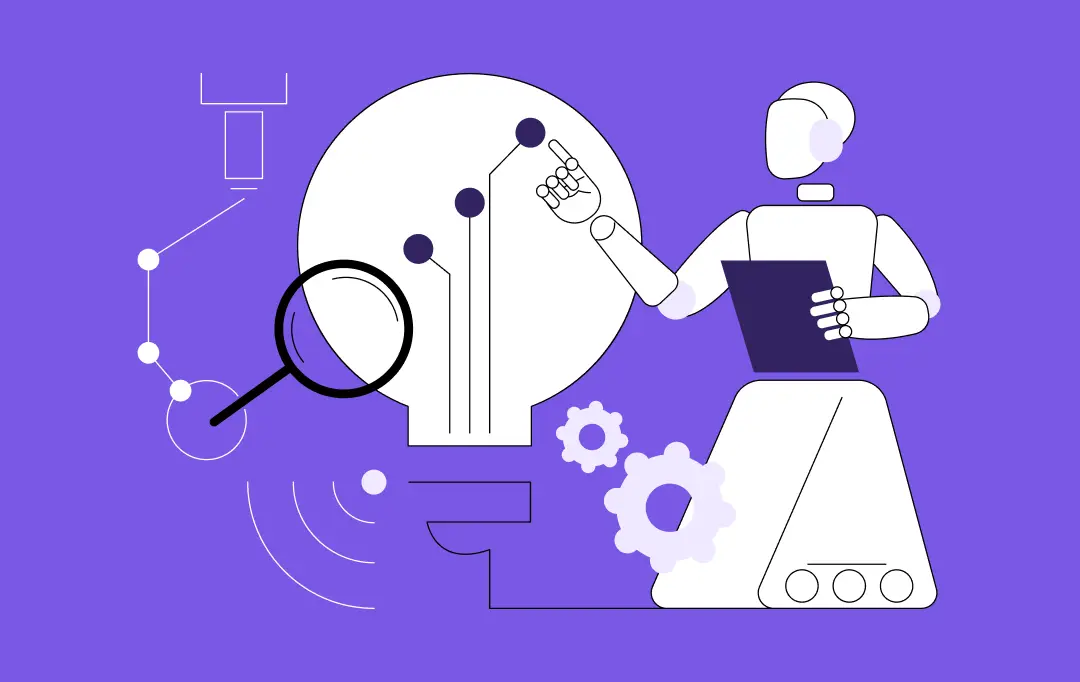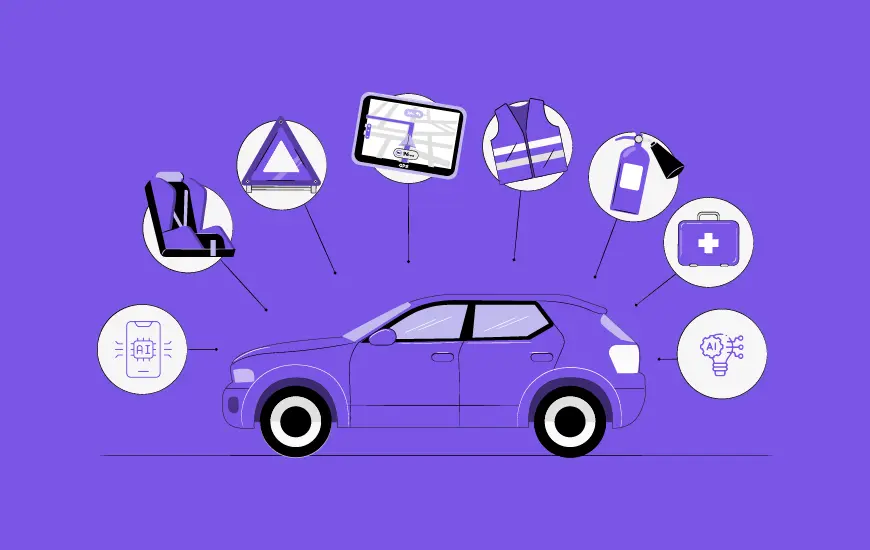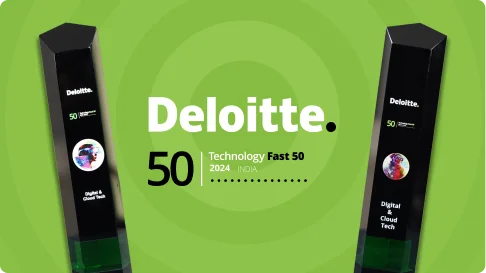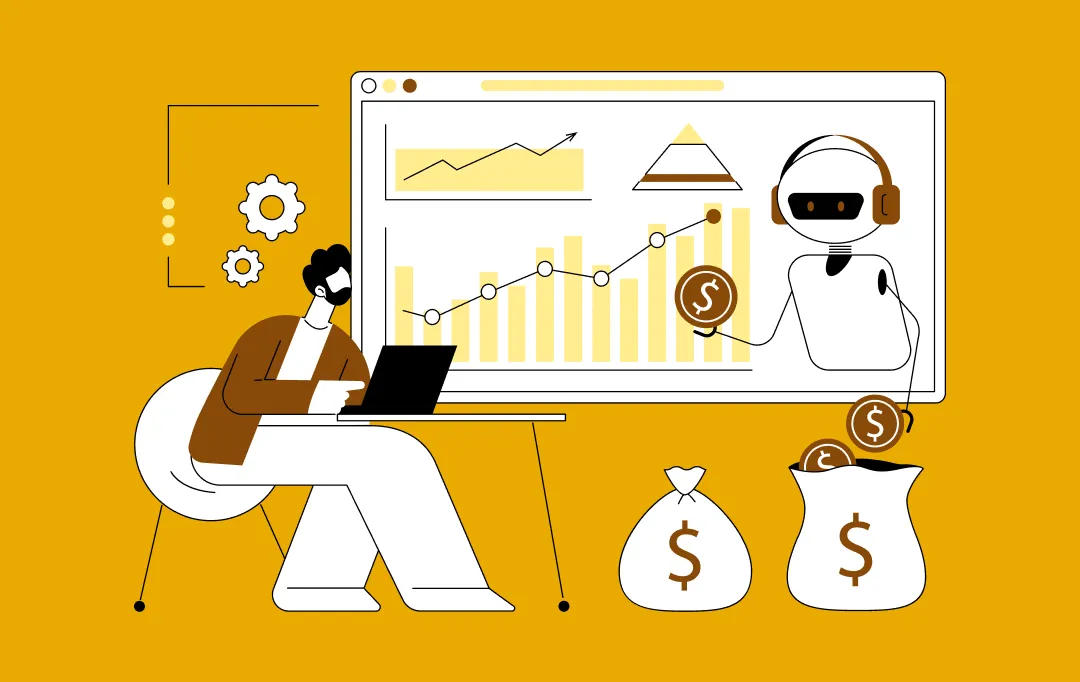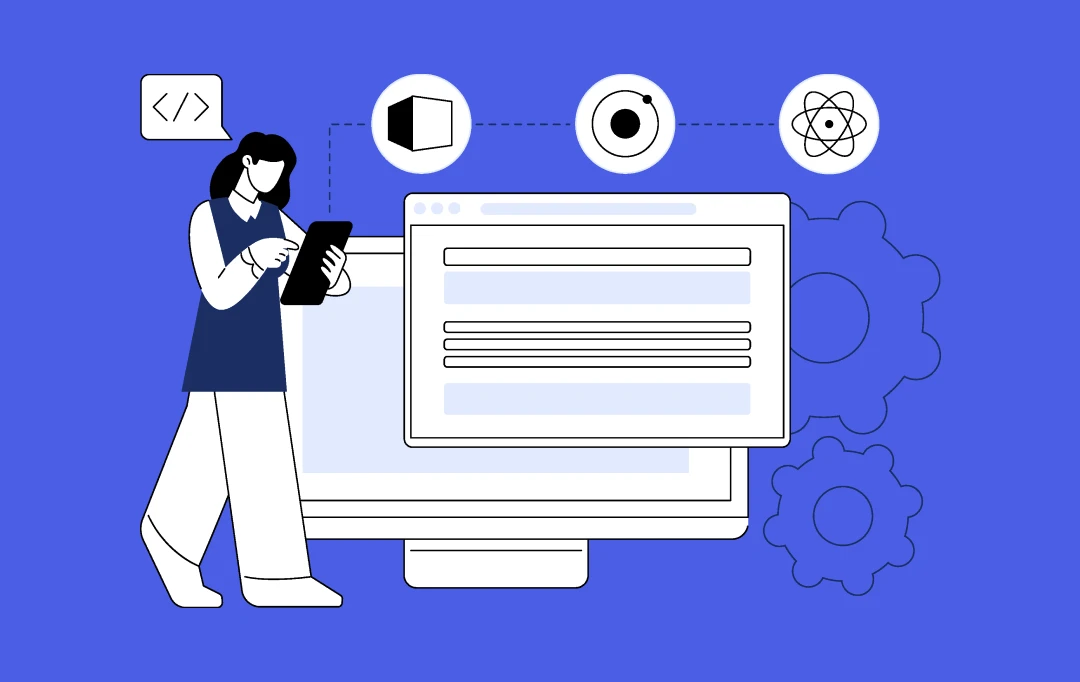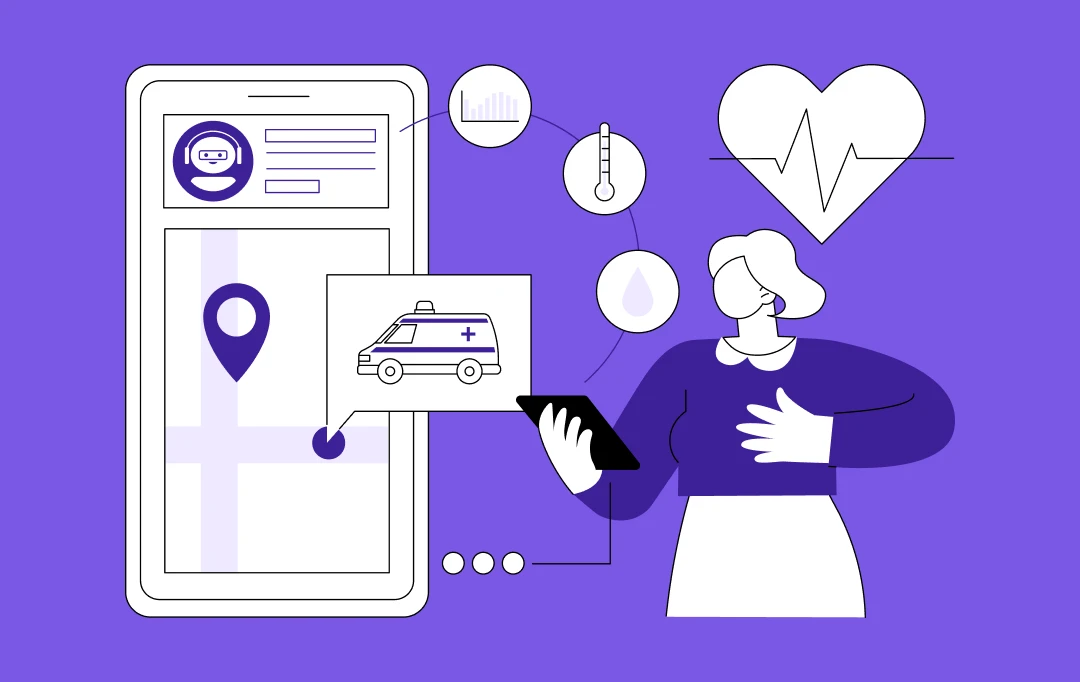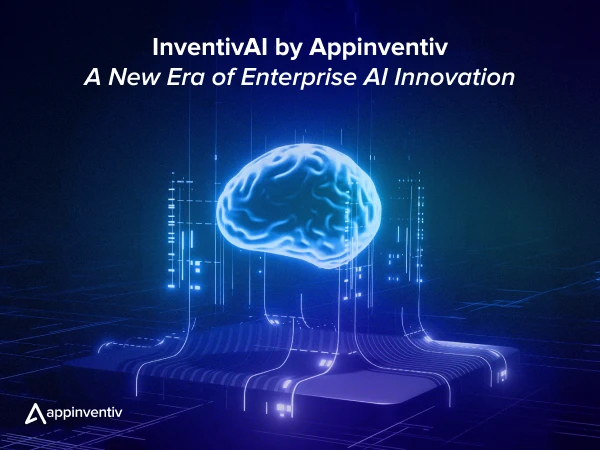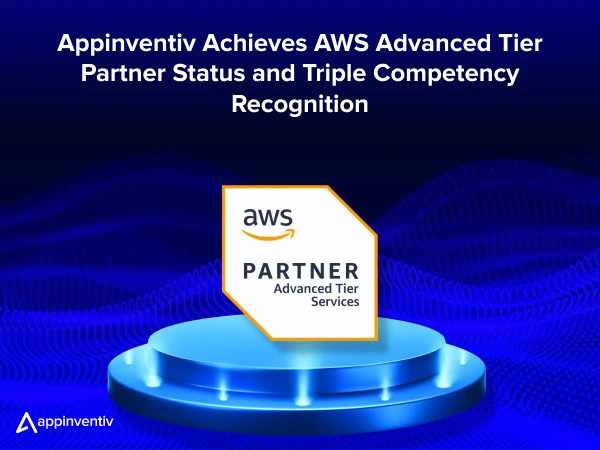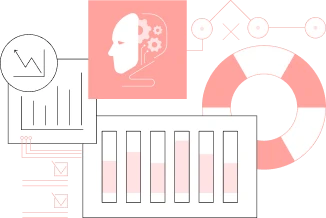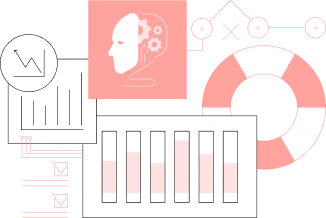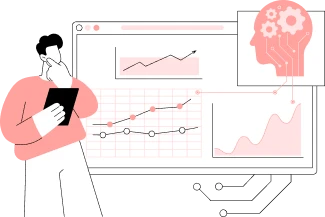- Why is AI-Based Demand Forecasting Essential Right Now?
- Benefits of Leveraging AI for Demand Forecasting
- Enhanced Accuracy
- Cost Reduction
- Improved Operational Efficiency
- Better Customer Satisfaction
- Real-Time Insights
- Strategic Decision-Making
- Increased Profitability
- Personalized Demand Prediction
- Smarter Market Analysis
- Instant Insight Generation
- Inventory Optimization
- Resource Planning Automation
- Real-World Use Cases of AI in Demand Forecasting Across Industries
- Retail and eCommerce
- Manufacturing
- Automotive
- Healthcare
- Energy
- Restaurants and Food
- Supply Chain Management
- AI for Demand Forecasting Implementation Process
- Identifying Objectives
- Data Collection and Preparation
- Selecting AI Algorithms
- AI Model Development
- Model Training and Validation
- Integration and Deployment
- Ethical and Regulatory Compliance
- Continuous Monitoring and Maintenance
- How AI Demand Forecasting Works?
- Watch Data Flows
- Gather and Clean
- Study With Models
- Output Forecasts
- Review and Refine
- Take Action
- Challenges in AI-Based Demand Forecasting
- Future of AI in Demand Forecasting
- More Real-Time Forecasting
- Deeper Integration With Other Systems
- Better Personalization
- Smarter Automation
- Wider Adoption Across Industries
- Appinventiv – Your Trusted Partner in AI Demand Forecasting Solutions
- FAQs
Key takeaways:
- AI-based demand forecasting is more efficient and error-free due to the real-time analysis of multi-source data.
- Real-time AI insights allow businesses to adapt to the current market trends and meet the changing customer demands rapidly.
- The application of AI-powered forecasting results in improved inventory, reduced stockouts, and customer satisfaction.
- Adoption of AI in demand planning will help businesses in cost savings, thereby giving them a competitive advantage.
Imagine you are the operations chief at a consumer goods company and walk into Monday’s demand meeting feeling rather confident. Now, at some point, you realize that yesterday’s forecast already feels out of date.
A flash promotion goes viral, a social trend spikes unexpectedly, and the inventory that looked perfectly balanced on Monday now threatens to be either overstocked or out of stock by Friday. That disconnect between what you plan and what customers buy is still one of modern supply chains’ most vital issues. Most companies accumulate extra stock, rush emails to suppliers, or add more people to spreadsheets. These moves buy a little time, yet the gap between forecast and real demand remains unresolved.
To resolve all these challenges, AI (Artificial Intelligence) offers a well-crafted solution. AI models analyze live signals such as point-of-sale data, weather reports, and social media activity. They spot demand patterns that planners and older tools often miss. This creates a dynamic forecast that helps merchandising, procurement, and logistics teams work together smoothly instead of reacting to sudden changes.
Starting with AI in demand forecasting does not mean replacing your entire system. Many businesses begin with a small use case, apply AI to a limited product range or region, and expand based on results. The key is having the right data, clear goals, and a plan to test and scale without disrupting day-to-day operations.
This blog will explain how AI is used in demand forecasting, where it brings the most value, how businesses implement it across functions, and provide real examples of success. Whether you are just exploring or ready to take the next step, this guide will help you move forward confidently.
Let’s build smarter systems that think ahead!
Why is AI-Based Demand Forecasting Essential Right Now?
In today’s modern business landscape, where businesses constantly compete for pole positions, the traditional methods of managing supply chains and logistics are no longer enough. Advanced artificial intelligence forecasting methods can process vast amounts of data at incredible speeds, offering a greater level of predictive accuracy previously unattainable.
Generative AI in demand forecasting further enhances this prospect by personalizing predictions based on individual customer preferences, historical data, and real-time interactions. This capability strengthens customer segmentation strategies and improves product recommendations, enhancing market responsiveness and customer satisfaction.
For instance, Zara, a fast-fashion retail brand, leverages AI-based demand forecasting to optimize its design and delivery according to consumers’ preferences. It deploys Gen AI and AI to analyze user feedback and social media channels to understand customer preferences and emerging fashion trends. Zara’s strategies to use AI-powered demand forecasting software result in improved product offerings and personalized marketing strategies that resonate with customers.
- Artificial intelligence in demand forecasting offers obvious advantages over traditional methods. According to McKinsey, AI-based forecasting transforms supply chain management by reducing errors by 20-50%. It optimizes warehousing costs (5-10% reduction) and slashes administration expenses (25-40% savings). Industries like telecommunications, electric power, natural gas, and healthcare are already benefiting from AI forecasting engines by automating up to 50% of workforce tasks, resulting in 10 to 15% cost reductions while gradually improving operational resilience.
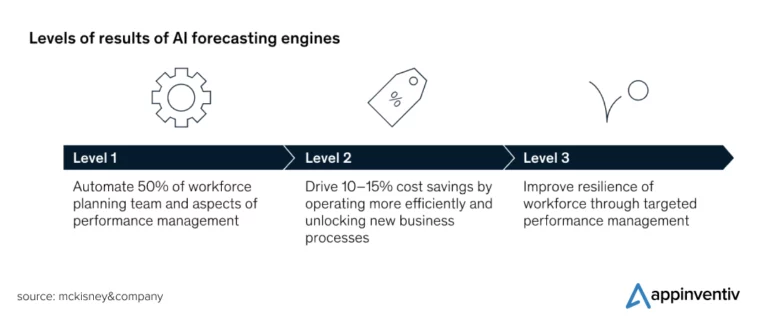
- According to PwC’s 2024 AI Business Predictions, nearly 49% of technology leaders report that AI is fully integrated into their companies’ core business strategies, with a third indicating full integration into products and services. These integrations have led to substantial gains, including 20% to 30% productivity improvements, market speed, and revenue across various sectors.
“AI adoption is progressing at a rapid clip, across PwC and in clients in every sector. 2025 will bring significant advancements in quality, accuracy, capability, and automation that will continue to compound on each other, accelerating toward a period of exponential growth.”
By Matt Wood, PwC US and Global Commercial Technology & Innovation Officer
- EY’s research reveals that 97% of senior business leaders investing in AI report positive returns on investment. Notably, 34% of these companies plan to invest $10 million in AI initiatives in the coming year, reflecting a significant increase from previous periods.
- A recent report from Gartner also suggests that 50% of supply chain leaders plan to use generative AI within the next 12 months, and another 14% have already started. On average, supply chain heads set aside about 6 percent of their 2024 budgets for AI tools.
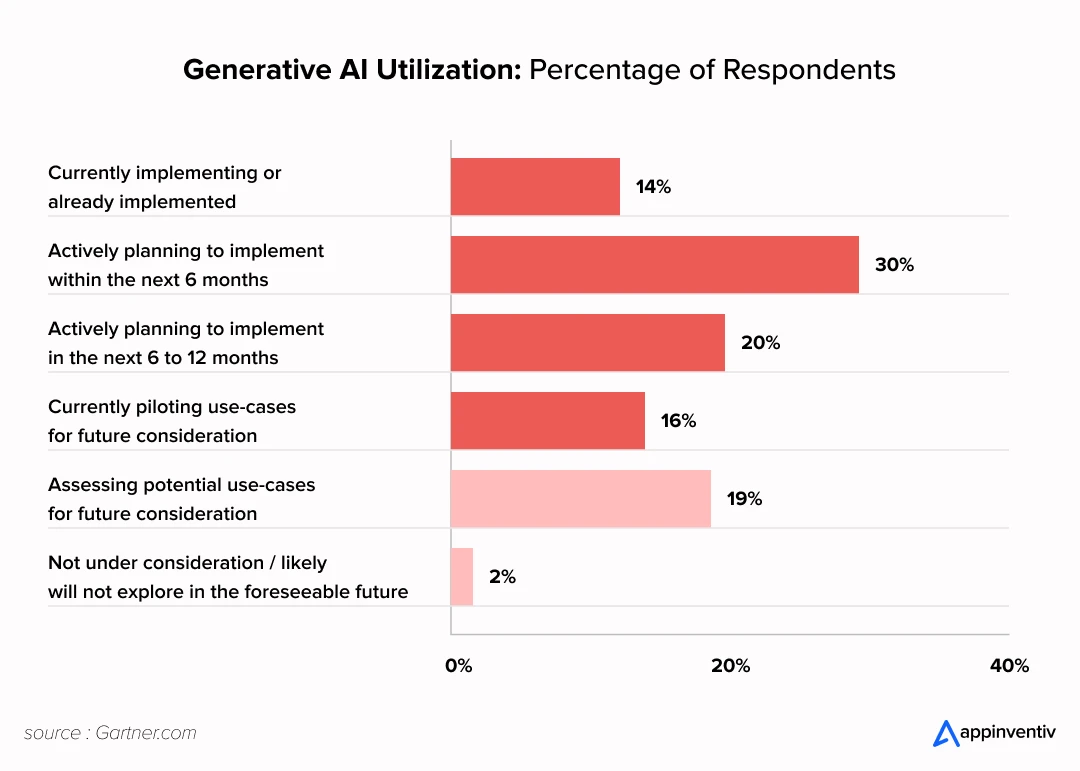
Simply put, using AI in demand forecasting is not just a tech upgrade but a smart business move. As markets become more complex and fast-changing, companies need better ways to understand what customers want and when. AI helps by quickly analyzing large amounts of data and spotting patterns in customer behavior.
With AI-powered demand forecasting software, businesses can make better decisions, manage inventory more effectively, and respond faster to changes. This leads to stronger performance and helps companies stay ahead in a highly competitive environment.
Still unsure why AI in demand forecasting is a cut above traditional methods? Here is a brief table highlighting the key differences between conventional methods and AI-based demand forecasting methods to help you make an informed decision:
| Aspect | Traditional Forecasting | AI-Based Demand Forecasting |
|---|---|---|
| Accuracy | Relies on historical sales trends, often leading to moderate prediction accuracy. | Leverages real-time, multi-source data for highly accurate forecasts. |
| Data Handling | Handles limited, structured data with manual entry. | Processes vast volumes of structured and unstructured data including social media, IoT, weather, etc. |
| Forecasting Frequency | Typically done weekly or monthly, limiting agility. | Continuous, real-time updates allow instant optimization with market changes. |
| Complexity | Based on simplistic models like linear regression. | Uses deep learning, neural networks, and generative AI for multi-layered demand mapping. |
| Error Rate | Prone to human errors, delayed responses, and bias in manual inputs. | Minimal error due to automation, real-time learning, and anomaly detection. |
| Adaptability | Needs manual tweaking for each new market event or disruption. | Automatically adapts to market shifts, trends, and seasonal fluctuations. |
| Scalability | Limited scalability, requires more resources and people as complexity increases. | Scales effortlessly across geographies, SKUs, or product lines without performance drop. |
| Prediction Precision | Captures basic sales patterns but misses external triggers. | Incorporates all little and big trends, customer behavior, and external factors dynamically. |
| Cost Efficiency | Increases operational costs due to overstocking or stockouts. | Optimizes inventory and reduces holding, warehousing, and admin costs. |
| Decision-Making | Informs only tactical decisions. | Empowers proactive, strategic planning with prescriptive recommendations. |
| Collaboration | Often disconnected between departments. | Creates a single source of truth across business units, fostering agile collaboration. |
| Time to Insights | Slower processing, delayed reports, and batch analysis. | Instant insights with dynamic dashboards and AI-driven alerts. |
Benefits of Leveraging AI for Demand Forecasting
In an era of unpredictable consumer base and constant market fluctuations, businesses increasingly rely on Gen AI and AI for demand forecasting to improve their supply chain efficiency. Gen AI and machine learning in demand forecasting provide businesses with actionable insights, reduce operational costs, optimize inventory management, and enhance overall supply chain efficiency.
Let’s delve deeper to understand the transforming benefits of demand forecasting powered by AI:
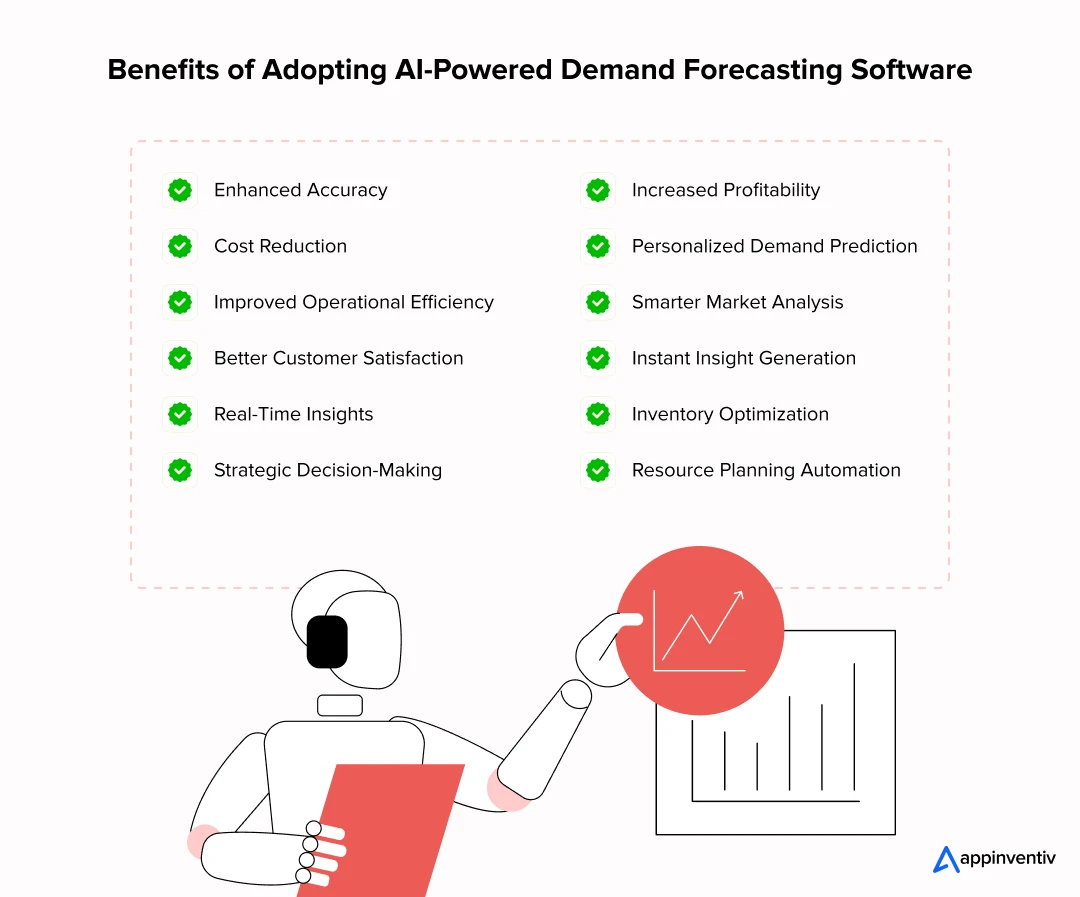
Enhanced Accuracy
Artificial intelligence forecasting methods analyze vast datasets and sophisticated algorithms for highly accurate predictions. This precision helps companies reduce errors by up to 50%, ensuring they effectively meet customer demand.
Cost Reduction
Reduced costs are one of the major benefits of AI-powered demand forecasting tools. Businesses can significantly reduce costs associated with overstocking and understocking by minimizing forecasting errors. For instance, it can help drop warehousing expenses by 5-10% and administration costs by 25-40%, leading to substantial savings.
Improved Operational Efficiency
AI in demand forecasting automates many repetitive tasks, freeing up human resources to invest their energy in more value-added activities. This automation can cut down workforce management tasks by up to 50%, enhancing overall operational efficiency.
Better Customer Satisfaction
AI for demand forecasting paves the way for accurate results that ensure the products are available when customers need them. This minimizes the risk of lost sales and failure to meet evolving customer demands. It can decrease product unavailability by up to 65%, ensuring enhanced customer satisfaction, engagement, and retention rates.
Real-Time Insights
Artificial intelligence in demand forecasting enables real-time analysis of diverse data sources, including social media platforms, market trends, emails, and economic indicators. This continuous analysis equips businesses with up-to-the-minute insights, enabling them to respond quickly to changing market conditions.
Strategic Decision-Making
Demand planning with AI gives businesses valuable insights into market trends and consumer preferences. This insight empowers businesses to make data-driven decisions, helping them plan better and stay ahead in the competitive landscape.
Increased Profitability
The combined benefits of AI-based demand forecasting—cost savings, operational efficiency, customer satisfaction, etc. —lead to increased profitability. Businesses can maximize their ROI while minimizing unnecessary expenses, unlocking the avenue of growth and innovation.
Personalized Demand Prediction
Generative AI in demand planning tailors forecasts to individual customer preferences using historical data and real-time interactions. It helps improve customer segmentation strategies and enhances product recommendations to meet specific consumer needs effectively.
Smarter Market Analysis
Generative AI captures insights not just from internal data but also from external factors like customer sentiment, competitor activity, and economic trends, giving businesses a much fuller view of the factors that drive demand.
Instant Insight Generation
Instead of relying on periodic reports, Generative AI generates live summaries and trend insights, allowing companies to react faster to sudden market changes.
Inventory Optimization
Gen AI predicts future demand and advises on the best inventory levels to maintain, helping businesses reduce waste, avoid stockouts, and minimize holding costs.
Resource Planning Automation
By forecasting demand for labor, raw materials, and logistics needs, Gen AI helps businesses allocate resources more efficiently, improving readiness and reducing last-minute disruptions.
Incorporating AI in demand forecasting is not just a technological upgrade; it is a strategic move that can transform how businesses operate, making them more resilient, efficient, and competitive in the market. It also delivers a clear lift in ROI by cutting excess stock, lowering fulfillment costs, and capturing more sales through accurate product availability.
“Successful AI governance will increasingly be defined not just by risk mitigation but by achievement of strategic objectives and strong ROI.”
By Jennifer Kosar, PwC AI Assurance Leader
After discussing the major benefits of demand forecasting tools powered by AI technology, let’s examine the sectors whose operations can be revolutionized by using artificial intelligence forecasting methods.
Real-World Use Cases of AI in Demand Forecasting Across Industries
AI-based forecasting offers innovative solutions to predict future trends, streamline processes, automate routine tasks, reduce costs, and improve productivity. By leveraging the advantages of AI in demand planning, organizations can gain actionable insights, identify areas of improvement, and make informed decisions in real-time.
Here are some industry-wise use cases of AI in demand forecasting, along with examples of the world’s leading organizations that rely on AI for demand forecasting to transform their supply chain management.
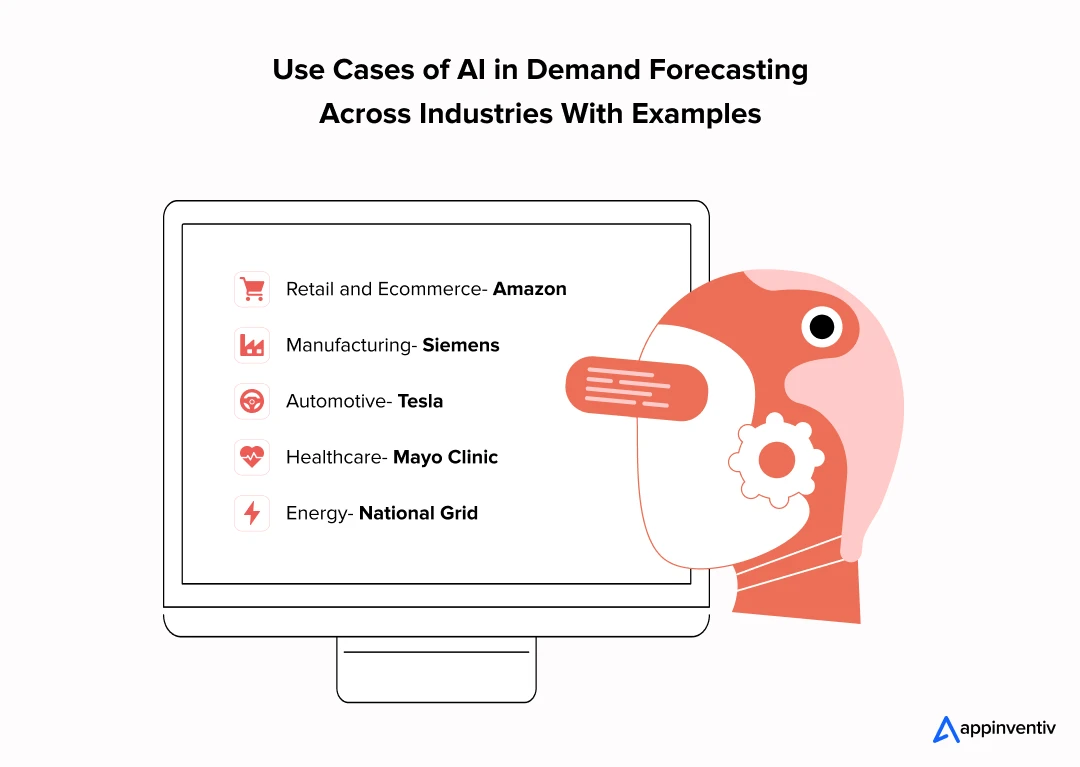
Retail and eCommerce
AI for demand forecasting revolutionizes retail and eCommerce by enhancing operational efficiency and customer satisfaction. It allows businesses to make data-driven decisions, leading to better inventory management and personalized shopping experiences.
- AI-driven demand forecasting is seeing robust gains in retail. According to Deloitte, 60% of retail buyers said that the usage of AI tools for demand forecasting improved their demand forecasts and inventory management.
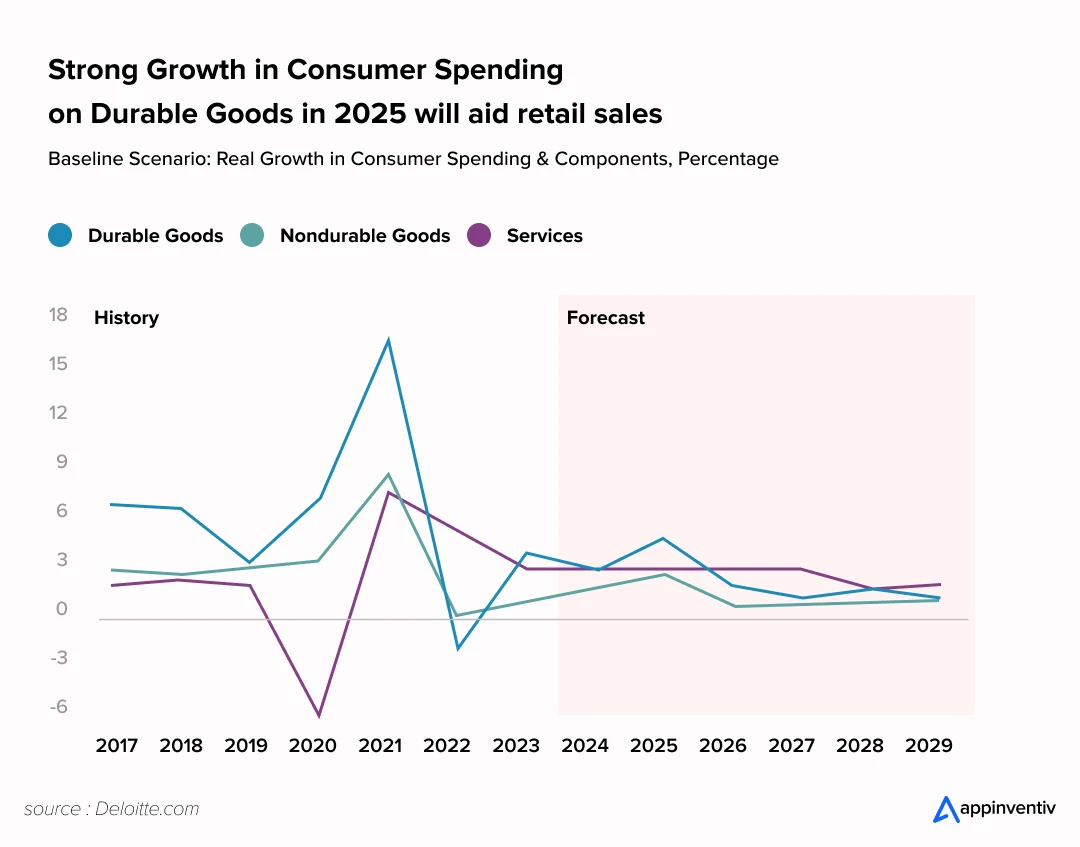
- Furthermore, as revealed earlier, the McKinsey Digital report also signifies that AI-based forecasting can cut supply chain errors by 20 to 50% and boost efficiency by up to 65% through fewer stockouts and lost sales.
- While AI for demand forecasting transforms inventory and supply management, AI-powered sales forecasting takes these predictive capabilities further by helping businesses forecast revenue, identify sales opportunities, and optimize pricing strategies in real time.
Additionally, retailers leverage the best AI demand forecasting tools to anticipate customer needs more accurately, optimize inventory, and even prevent lost sales. Simply put, it’s high time for retail businesses to embrace AI forecasting to optimize stock levels, meet consumer demand, and stay competitive.
Here are some of the most notable applications of AI forecasting in the retail sector:
- Inventory Management: AI in demand planning can predict the requirements, helping retailers optimize inventory levels and reduce the risk of stockouts or overstock.
- Personalized Marketing: AI forecasts future purchases by analyzing consumer behavior, enabling more targeted and effective marketing campaigns.
- Dynamic Pricing: Artificial intelligence in retail adjusts prices in real-time based on demand forecasts, maximizing revenue and competitive positioning.
Real Example: Amazon Deploys AI-Powered Demand Forecast Solution For Pricing Strategies
Amazon uses AI to monitor competitor prices, market trends, and customer behavior in real time. This strategy helps the retail giant optimize its product pricing strategies across the global distribution network and keep up with competitor pricing, enhancing competitiveness and maximizing revenue.
By optimizing the demand forecasting with AI, Amazon ensures timely inventory replenishment, precise product availability, and dynamic pricing that aligns perfectly with shifting consumer demand, ultimately driving higher conversions and customer satisfaction.
Also Read: Cost to Develop a Marketplace App Like Amazon
Manufacturing
AI demand forecasting enhances productivity and efficiency in the manufacturing sector by optimizing production schedules and supply chain operations. It enables manufacturers to respond swiftly to market changes and maintain high-quality standards.
Manufacturers are rapidly adopting AI to enhance demand planning and operations. According to a Mckinsey report, companies that have successfully implemented AI-enabled supply chain management have reported substantial benefits, including a 15% reduction in logistics costs, a 35% decrease in inventory levels, and a 65% improvement in service levels compared to competitors who are slower to adopt these technologies.
Businesses report that AI-driven forecasts help streamline production schedules and reduce inventory bottlenecks. To say the least, manufacturers leveraging AI for forecasting can easily minimize waste, improve responsiveness, and stay agile in a rapidly shifting market.
Here are some of the most notable applications of AI forecasting in the manufacturing sector
- Seasonal Demand Forecasts: An AI model for demand forecasting analyzes historical sales data across various seasons. These insights empower manufacturers to forecast seasonal demand fluctuations and adeptly meet users’ demands during peak seasons.
- Supply Chain Optimization: By leveraging AI for the supply chain, manufacturers can efficiently predict raw material needs, ensuring smooth supply chain management with minimal disruptions.
- Production Planning: AI can meticulously forecast demand for finished goods and predict production volume, helping manufacturers adjust production schedules, reduce downtime, and maintain consistent quality standards.
Real Example: Siemens Deploys AI-Powered Demand Forecasting For Production Optimization
Siemens, a global manufacturing company, uses AI demand forecasting to optimize production schedules. By analyzing data from various sources, including market trends, historical sales, and supplier performance, Siemens adjusts its production processes in real-time, meeting demand fluctuations, reducing lead times, and increasing operational efficiency.
Automotive
AI in demand forecasting helps the automotive industry streamline operations from production to aftermarket services. It ensures optimal inventory levels and enhances customer satisfaction through efficient resource management.
A 2024 McKinsey survey revealed that automotive companies increasingly adopt AI to enhance demand forecasting and strengthen their supply chains. According to the report, over 40% of automotive and manufacturing executives are investing up to EURO 5 million in generative AI research and development, with more than 10% allocating over EURO 20 million.
This significant investment underscores the industry’s commitment to leveraging AI to improve forecasting accuracy, streamline production schedules, and reduce inventory bottlenecks.
Here are some of the most notable applications of AI forecasting in the automotive industry:
- Spare Parts Management: AI plays a pivotal role in forecasting demand for spare parts, helping automotive companies maintain optimal inventory levels.
- Sales Forecasting: AI, combined with sales forecasting software, analyzes and predicts vehicle sales trends, enabling companies to make more accurate production planning and effective dealership inventory management.
- Aftermarket Services: AI anticipates demand for maintenance and repair services, allowing for better resource allocation and customer service.
Real Example: Tesla Deploys Demand Forecast Solution For Production Planning and Scheduling
Tesla, the leading electric vehicle (EV) manufacturer, faces a changing market with unpredictable demand for different car models. To address this challenge, Tesla employs AI-powered demand forecasting software for its vehicles, optimizing production schedules and enhancing production efficiency, ensuring timely fulfillment of customer orders.
Healthcare
AI demand forecasting improves patient care and operational efficiency in the healthcare sector by ensuring timely resource availability and optimizing staff allocation. It helps medical professionals respond effectively to patient needs and supply chain challenges.
Healthcare organizations increasingly adopt AI to enhance demand forecasting and optimize resource allocation. According to Healthcareitnews, businesses use AI and machine learning in predictive analytics for bed demand forecasting. This enables them to optimize staffing, allocate beds, and streamline operations, improving patient care and overall efficiency.
Simply put, this trend signifies that proactive healthcare operations are already underway and AI-driven forecasting tools are helping anticipate patient volumes and supply needs, ensuring timely care delivery and efficient resource management.
Here are some of the most notable applications of AI forecasting in the healthcare sector
- Hospital Bed and Staffing Needs: By analyzing patient influx, seasonal trends, and patterns of disease outbreaks, AI forecasts the demand for hospital beds and staffing needs, enabling the authorities to ensure the hospitals and clinics are well-stocked with optimal facilities.
- Pharmaceutical Supply Chain: AI optimizes the production and distribution of medications by forecasting demand, preventing shortages, and ensuring the timely availability of essential pharmaceuticals to meet demand. Various healthcare service providers are investing in medical courier app development.
- Personalized Medicine Prediction: AI in healthcare facilitates personalized medicine demand forecasting by analyzing patient records, genetic data, and treatment outcomes.
Real Example: Mayo Clinic Deploys Demand Forecast For Patient Visit Forecasting
Mayo Clinic employs demand planning artificial intelligence software to accurately forecast patient visits, enabling efficient resource allocation and optimal staffing levels. This predictive capability helps the clinic maintain high standards of patient care by ensuring that necessary medical supplies and personnel are available when needed.
Energy
Use cases of AI in demand forecasting enable the energy sector to manage supply and demand efficiently. It enhances grid reliability and supports the integration of renewable energy sources, leading to a more sustainable and stable energy supply.
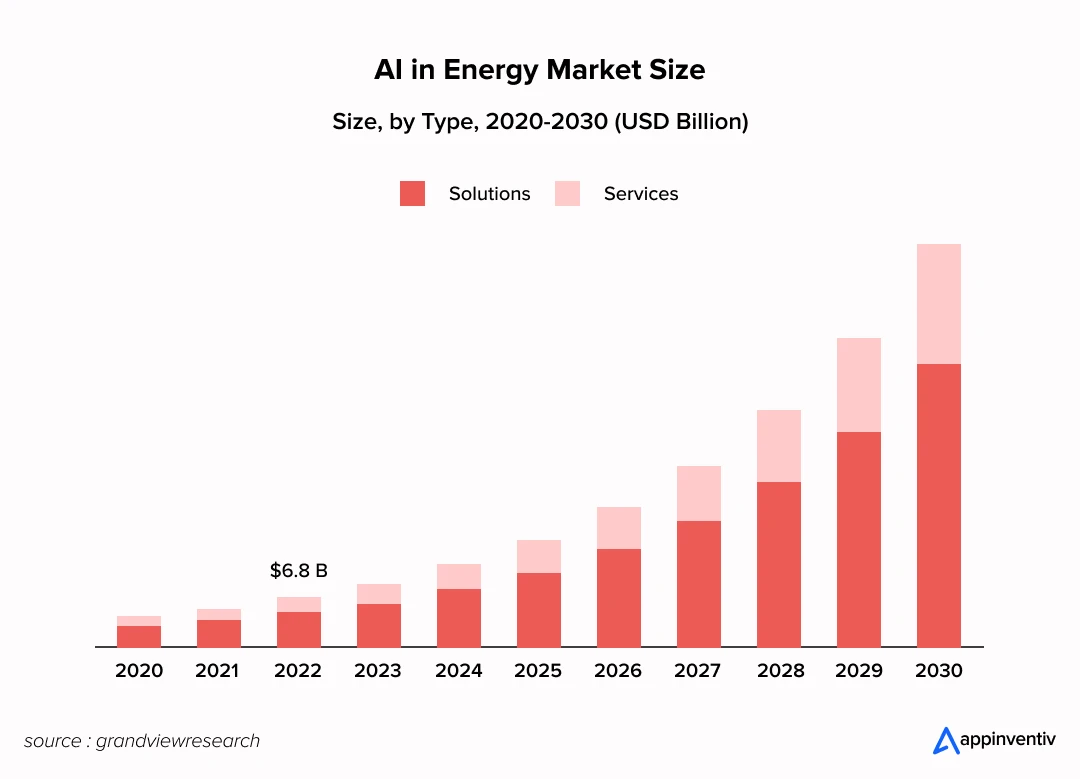 According to Grand View Research, the global AI in energy market is projected to reach $54.82 billion by 2030, growing at a CAGR of 30.1% from 2024 to 2030. This growth is driven by the adoption of AI technologies such as predictive analytics and machine learning in demand forecasting, enabling energy companies to analyze vast datasets from smart meters and IoT devices. These insights facilitate improved decision-making in grid management and renewable energy integration, allowing for better load forecasting and resource allocation.
According to Grand View Research, the global AI in energy market is projected to reach $54.82 billion by 2030, growing at a CAGR of 30.1% from 2024 to 2030. This growth is driven by the adoption of AI technologies such as predictive analytics and machine learning in demand forecasting, enabling energy companies to analyze vast datasets from smart meters and IoT devices. These insights facilitate improved decision-making in grid management and renewable energy integration, allowing for better load forecasting and resource allocation.
Here are some of the most notable applications of AI forecasting in the energy sector
- Predictive Maintenance: AI analyzes historical data and real-time sensor inputs to predict equipment maintenance needs, enabling energy companies to schedule maintenance activities efficiently and prevent unexpected breakdowns.
Also Read: Predictive analytics software development – Benefits, features, process, costs
- Demand Forecasting for EVC Stations: AI predicts future demand for electric vehicle (EV) charging services based on historical usage patterns, events, and weather forecasts. The use of AI for demand prediction enables operators to optimize charging station availability and manage peak loads.
- Renewable Energy Management: AI enhances grid integration and storage solutions by forecasting renewable energy generation and consumption, facilitating the sustainable integration of renewable sources into the energy mix.
Real Example: National Grid Deploys AI For Energy Demand Forecasting
National Grid employs AI to analyze historical data and real-time inputs to forecast energy demand and supply. This predictive capability enhances grid reliability by optimizing resource allocation and operational efficiency, ensuring a stable and sustainable energy distribution network.
Restaurants and Food
Demand forecasting by AI is assisting restaurants in making better plans, anticipating the arrival of customers, their favorite meals, and ingredients that the restaurant must acquire. It uses order history, weather, event, and local patterns data to plan the menu, purchase, and staffing.
Restaurants that apply these insights have fewer food waste levels and massive cost savings. They can also have the correct demand forecasts to stock the perishable ingredients in the amount that is needed just right, without either having excess or spoilage.
Key Applications:
Menu and Inventory Planning: This project forecasts the dishes that are most likely to sell and the quantity of each ingredient to be purchased.
Staff Optimization: This predicts the time of the day when there is high traffic to place the staff there and reduce labor expenses, so that the staff will be able to serve the customers smoothly.
Real Example: Domino’s Uses AI to Forecast Daily Demand
Domino’s is utilizing AI forecasting to predict order volume in each location. The system considers the weather, local events, and past trends in order to control the inventory and deliver personnel. This saves on ingredient wastage, and there are early deliveries even in cases of high demand.
At Appinventiv, we helped Domino’s refine its UI/UX strategy, increasing its conversion rate by 23%.
We integrated several interactive features into the app, including menu categorization, online ordering, order customization, store locator for home delivery, secure in-app payments, and real-time delivery tracking, which made the app highly engaging.
Supply Chain Management
The AI forecasting enhances the reliability and responsiveness of the supply chain by anticipating demand, identifying possible bottlenecks, and optimizing logistics. It enables businesses to align production and distribution with the real-world conditions rather than working with fixed schedules.
Firms that plan their supply chains with AI say that their forecast accuracy is better, and stockouts are reduced. AI enables proactive decision-making and reduces disruption by incorporating live data on suppliers, transport networks, and markets.
Key Applications:
Demand and Procurement Planning: The product requirements are predicted to achieve optimal sourcing and manufacturing timetables.
Logistics and Distribution: Foresees delays and corrects the road or warehouse assignments to keep the shipments on schedule.
Real Example: Amazon Uses AI for Global Supply Chain Efficiency
The AI system of Amazon predicts the demand for products in the markets and seasons and optimizes the distribution of inventory in the fulfillment centers. This will guarantee quicker delivery, reduced storage expenses, and enhanced inventory during the high shopping season.
AI for Demand Forecasting Implementation Process
Implementing AI in demand forecasting involves a strategic approach to ensure efficient integration into the existing system. Here is a step-by-step process on how to implement AI in demand forecasting:
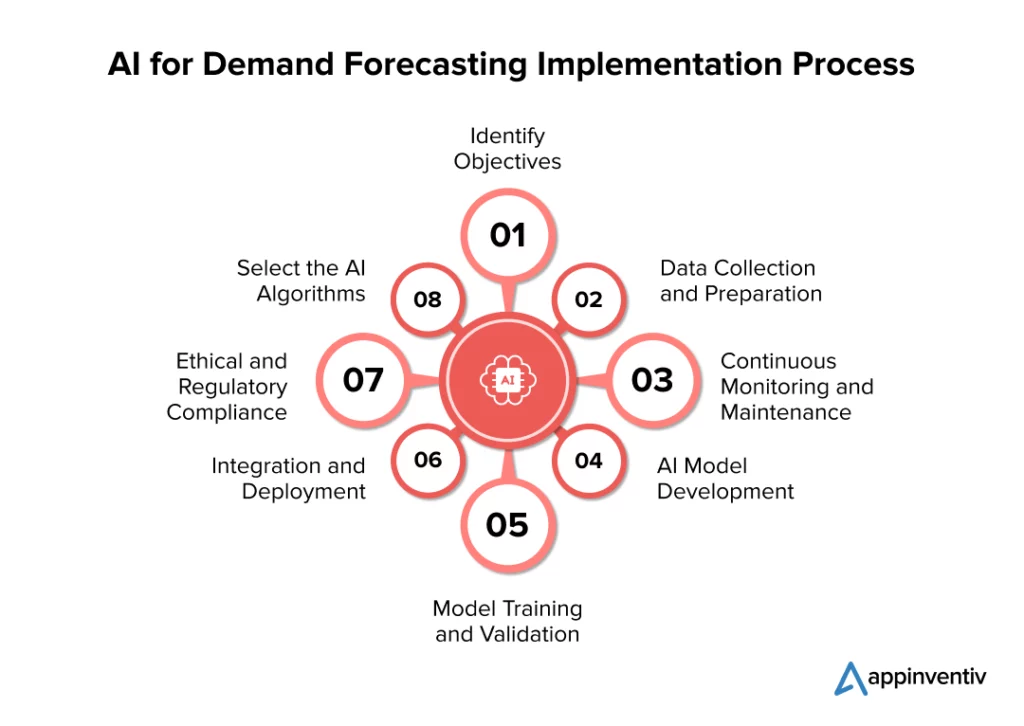
Identifying Objectives
Identify and outline specific objectives for AI implementation, such as improving forecast accuracy, optimizing inventory management, or enhancing operational efficiency. Also, determine the areas, products, or services where you want to integrate AI-powered demand forecasting tools.
Data Collection and Preparation
Collect data from various sources, including historical sales data, market trends, customer behavior patterns, and external factors like economic indicators or weather conditions. Also, cleanse and preprocess the data to ensure its reliability and relevance or address any other data quality issues.
Selecting AI Algorithms
Choose the relevant AI algorithms based on the nature of the data and forecasting requirements. ML models (e.g., regression, neural networks), linear regression, decision trees, and time series analysis techniques (e.g., ARIMA) are the most common AI algorithms.
AI Model Development
Develop an advanced AI model that can efficiently analyze and process large volumes of data to generate accurate demand forecasts. Create compelling UI/UX and integrate advanced features into the application for enhanced predictive capabilities.
Model Training and Validation
Train AI models using historical data to learn patterns, correlations, and underlying trends relevant to demand forecasting. Furthermore, validate its accuracy, reliability, and performance through rigorous testing and cross-validation methods.
Integration and Deployment
To generate actionable predictions, integrate AI-powered demand forecasting software into existing supply chain management systems or enterprise resource planning (ERP) platforms. You can partner with an AI development company to ensure seamless development and deployment of the AI model.
Ethical and Regulatory Compliance
Adhere to ethical guidelines for the responsible use of AI, including transparency, fairness, and data privacy considerations throughout the forecasting process. Also, comply with industry standards and relevant regulations like GDPR to ensure data privacy and security.
Continuous Monitoring and Maintenance
Continuously monitor the AI models to evaluate accuracy, detect anomalies, and gather user feedback. Use this analysis to make iterative improvements to the model, enhancing forecasting precision and adaptability over time.
How AI Demand Forecasting Works?
Demand forecasting with AI follows a clear, repeatable flow that turns raw data into timely insight. The framework breaks this flow into six practical steps that businesses need to follow:
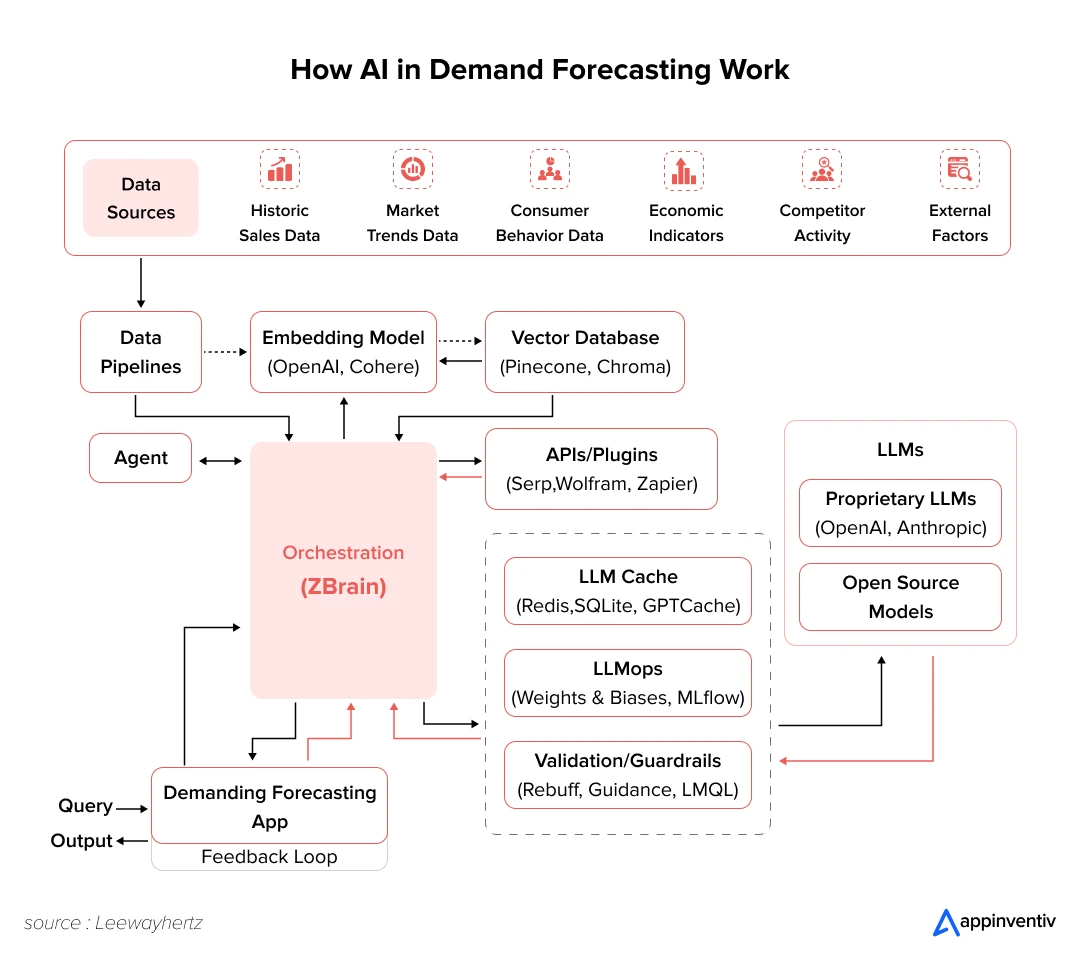
Watch Data Flows
AI begins by watching all the data sources that can impact demand. This includes sales numbers, website traffic, weather updates, market news, and social media mentions. It collects all these signals in real time, giving the system a live picture of what’s happening outside and how it might affect customer demand.
Gather and Clean
Once the data is collected, it’s brought together in one place and cleaned. This means removing duplicate entries, fixing missing values, and ensuring all the data is in the same format. Cleaning the data is important because the model needs reliable information to learn from, and incomplete data can lead to poor predictions.
Study With Models
After the data is clean, machine learning algorithms study it. These models look for seasonal demand changes, how price affects buying decisions, and which regions prefer certain products. They also detect sudden changes caused by things like promotions or viral trends. Based on this learning, the model understands how demand will likely behave.
Output Forecasts
The AI system then turns its findings into demand forecasts for the days, weeks, or months ahead. These forecasts are automatically sent to dashboards and planning tools teams use in purchasing, logistics, and finance. This ensures everyone uses the same, updated numbers to plan their actions.
Review and Refine
Once the forecasts are generated, businesses need to review them. You might add important information the model hasn’t considered yet, like upcoming product launches, policy changes, or local events. This feedback is used to retrain the AI model, helping it become more accurate over time.
Take Action
With the final forecasts in hand, teams adjust production, stock levels, and marketing plans. As new data comes in, the entire process repeats automatically. This keeps the planning always in sync with what’s actually happening in the market without needing constant manual updates.
“If we combine generative AI with the basket of automation technologies, we’re looking at a potential global GDP growth of $4.4 trillion, larger than the size of the United Kingdom.”
By Lareina Yee, Senior Partner, McKinsey & Company
Challenges in AI-Based Demand Forecasting
While AI brings clear advantages to demand forecasting, it also comes with its own set of challenges. If not addressed properly, these roadblocks associated with AI for demand forecasting can affect accuracy, adoption, and the overall success of implementation.
Let’s take a detailed look at the key challenges of AI-powered demand planning, their impact on businesses, and possible solutions to overcome them:
| Challenge | How It Affects | Solution |
|---|---|---|
| Poor Data Quality | Leads to inaccurate forecasts and unreliable outputs | Clean and standardize data regularly. Use data validation tools to remove errors |
| Lack of Historical Data | Makes it hard for AI to learn patterns | Start with available data and use external sources like market trends or public datasets |
| Overdependence on Technology | Teams may stop applying human judgment | Use AI as a support tool. Combine it with expert insights and cross-functional discussions |
| Resistance to Change | Slows down adoption within teams | Educate employees on benefits. Start with small use cases to build trust and confidence |
| High Implementation Costs | Prevents smaller companies from adopting AI | Use cloud-based AI tools or partner with firm offering scalable and optimized solutions |
| Limited Skilled Resources | Delays development and integration | Hire external AI experts to work as per your requirements |
| Data Silos Across Departments | Limits AI’s access to complete information | Integrate systems and encourage data sharing across departments |
| Frequent Changes in Consumer Demand | Makes it hard to maintain accurate models | Use real-time data feeds and regularly update AI models with latest patterns |
| Complexity of AI Models | Hard to understand and trust AI predictions | Use explainable AI tools that show how decisions are made |
| Privacy and Data Security Concerns | Limits the use of customer data | Follow data protection laws and use anonymized data when needed |
| Lack of Customization | One-size-fits-all models may not suit all businesses | Build flexible models tailored to business size, region, and product type |
Future of AI in Demand Forecasting
AI in demand forecasting is just getting started. As the technology grows more advanced and accessible, its role in business planning will only become more important. Here is what we can expect shortly.
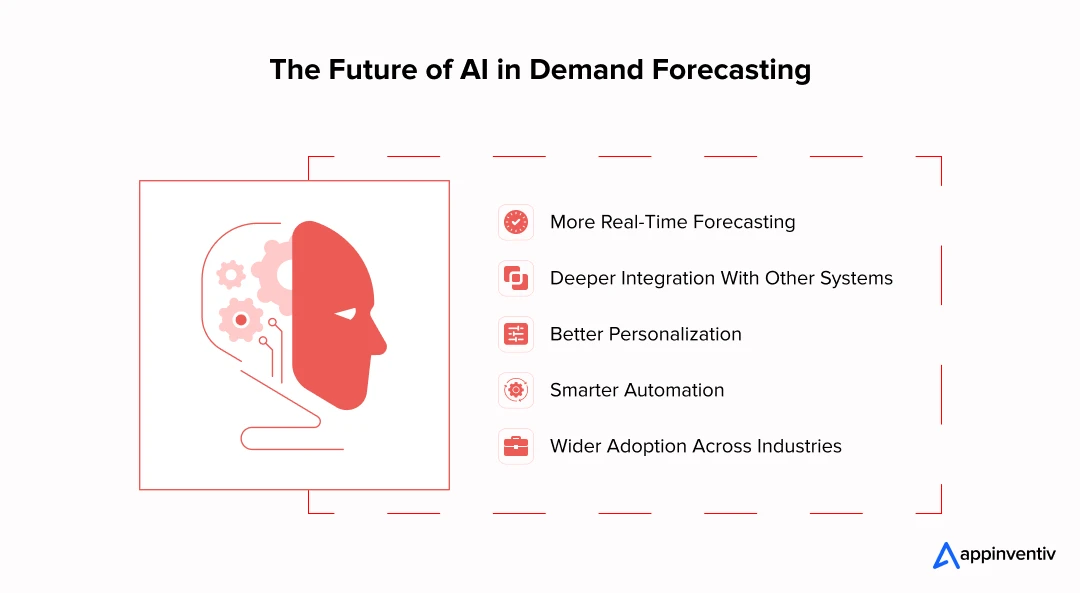
More Real-Time Forecasting
Demand forecast solutions will no longer offer weekly or monthly updates. AI systems will use live data to adjust predictions instantly, helping companies react faster to changes in demand and avoid last-minute surprises.
Deeper Integration With Other Systems
AI forecasting tools will work more closely with systems in sales, marketing, finance, and logistics. This integration of AI in demand prediction tools will create a connected flow of information across departments, making planning more efficient and accurate.
Better Personalization
As AI learns from individual customer behavior, it will help businesses offer more tailored promotions, stock the right products in the right places, and improve customer satisfaction.
Smarter Automation
AI will not just predict demand but also suggest actions like how much to order, when to restock, and where to ship. This will reduce manual work and speed up decision making across the supply chain.
Wider Adoption Across Industries
Industries like healthcare, energy, and even public services will start using demand forecasting software with machine learning and AI integration to plan resources, manage inventories, and better serve people. This will move beyond retail and manufacturing into more sectors.
Appinventiv – Your Trusted Partner in AI Demand Forecasting Solutions
For businesses looking to leverage the full potential of AI demand planning and forecasting, partnering with an AI development company like Appinventiv can be a strategic move. With our extensive experience and expertise in developing reliable AI-driven solutions, we can help streamline your supply chain processes, optimize resource allocation, and elevate your business to new heights of success.
Here are some other reasons why you should partner with Appinventiv for AI demand forecasting tool development and implementation:
- We have a proven track record of delivering 3000+ successful projects across 35+ industry verticals in 25+ countries.
- Our suite of AI services includes the development and implementation of AI applications, Generative AI solutions, smart AI assistants and AI consulting services, AI security, and more.
- We have a team of 700+ AI and ML experts who are dedicated to transforming your vision to life and driving innovation.
- Our expertise in AI product development is showcased through our work with clients like YouComm, Mudra, Vyrb, and JobGet.
- We have been awarded by Clutch, Good Firms, Times Business, Deloitte, Economic Times, and other prestigious firms for our remarkable contribution to app and software development.
- We are globally recognized as the Fastest Growing Technology Company and Tech Company of the Year.
Contact us today to embrace the future of AI for demand forecasting and stay ahead in today’s competitive age.
FAQs
Q. How is AI used in demand forecasting?
A. AI in demand forecasting leverages advanced technologies like predictive analytics, ML, NLP, image recognition, and IoT. These technologies analyze vast troves of data to identify patterns, predict future demand, and improve accuracy. This enables companies to improve forecasting accuracy, optimize inventory levels, save costs, and enhance customer insights.
Q. How can businesses benefit from AI demand forecasting?
A. The benefits of AI-based demand forecasting techniques or solutions are profound and far-reaching for businesses. Here are some of the most notable advantages of AI demand planning:
- Enhanced Accuracy
- Cost Reduction
- Improved Operational Efficiency
- Better Customer Satisfaction
- Real-Time Insights
- Strategic Decision-Making
- Increased Profitability
To gain an in-depth understanding of these advantages, please refer to the above blog.
Q. What data is needed for AI demand planning?
A. AI demand planning requires historical sales data, inventory records, market trends, seasonal patterns, and external factors like weather, holidays, or economic indicators.
Q. Can AI-powered demand planning software integrate with existing systems?
A. Yes, most of the top AI demand forecasting software for business is designed to integrate seamlessly with ERP, CRM, and supply chain management systems, ensuring smooth data flow and compatibility.
Q. How does AI demand forecasting work?
A. AI for demand forecasting works by leveraging advanced algorithms and data analysis techniques to predict changing market trends and consumer demand for products and services. Here is a step-by-step process of how AI demand forecasting works:
- Data Collection: AI collects extensive data from various sources, such as sales records, market trends, social media, economic indicators, and weather patterns.
- Data Processing: After collecting the relevant data, the data is cleansed and processed to ensure accuracy and relevance for analysis.
- Model Training: Based on this data, the AI models are trained to recognize factors influencing demand.
- Prediction Generation: Once trained, the AI models generate demand forecasts by analyzing current and historical data.
- Continuous Learning: AI systems continuously learn and adapt from new data, refining their predictions and becoming more accurate over time.
- Decision Support: The generated predictions provide actionable insights for businesses to make informed decisions on inventory management, production planning, and resource allocation.
Q. What type of forecast should be used for strategy, sourcing, and location decisions?
A. For strategic decisions like sourcing, expansion planning, and location selection, businesses should rely on AI-powered long-term demand forecasting. We develop custom AI forecasting solutions that analyze historical data, market trends, seasonality, and external variables like economic shifts or climate impact. These forecasts empower businesses to make confident, forward-looking decisions that align supply chain strategy with future demand. By partnering with us, businesses like yours can unlock accurate, scalable, and adaptive forecasting tools tailored to your strategic goals.
Q. Is AI in demand planning expensive to implement?
A. The advantages of AI-based demand planning come with a cost. The cost estimation of AI in demand planning depends on the scale and tools used. Cloud-based AI solutions can be cost-effective for smaller businesses, while large enterprises may invest in custom systems.
Q. What are the key benefits of using AI-powered demand planning software?
A. Some noticeable advantages of AI-powered demand planning software include:
- Improved Accuracy: AI models provide precise demand forecasts.
- Cost Savings: Optimizes inventory levels, reducing overstock or stockouts.
- Efficiency: Automates data analysis and forecasting processes.
- Scalability: Handles growing data volumes and complex supply chains.
Q. Which method of forecasting helps to smooth sudden fluctuations in demand?
A. Moving average and exponential smoothing methods are often used to reduce sudden changes in demand. These AI forecasting techniques work by using past data to even out short-term ups and downs. We can develop AI-powered models that take this a step further by automatically adjusting to seasonality, trends, and outside factors in real time. This helps businesses keep their forecasts stable, even when the market is unpredictable, leading to better planning and inventory management.


- In just 2 mins you will get a response
- Your idea is 100% protected by our Non Disclosure Agreement.

How to Build a Custom Multilingual Chatbot? Features, Process, Costs
Key takeaways: Multilingual Chatbots Drive Revenue Growth: Companies see higher conversion rates when customers can interact in their native language, with nearly 75% of global customers preferring to buy from websites in their preferred language. Beyond Translation to Cultural Intelligence: Successful implementations require cultural adaptation, not just language translation. Systems must understand context, emotion, and…

How Much Does It Cost to Build an AI App in Dubai?
Key takeaways: AI app costs in Dubai typically range from AED 80,000 for simple builds to AED 800,000+ for enterprise systems. Dubai is past AI experimentation, and not investing now means catching up later at higher cost. The real budget is driven by data, integrations, architecture, and compliance, not just app features. Hidden costs like…
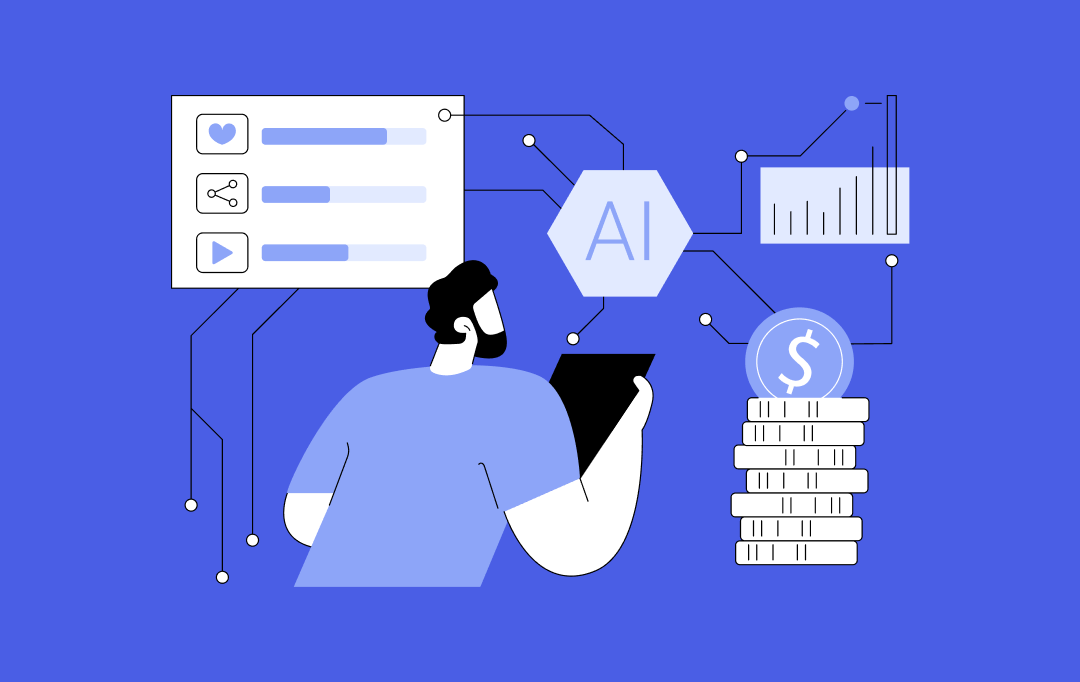
How AI Tokenization is Enabling Secure and Transparent Asset Ownership in 2026
By 2026, AI tokenization has moved beyond early-stage experiments and pilot projects. Tokenizing real-world assets has become a serious commercial strategy for financial institutions, supply chain operators and technology-driven enterprises. A 2025 report by the World Economic Forum in collaboration with Accenture highlights tokenization as a key mechanism for value exchange in modern financial markets.…
